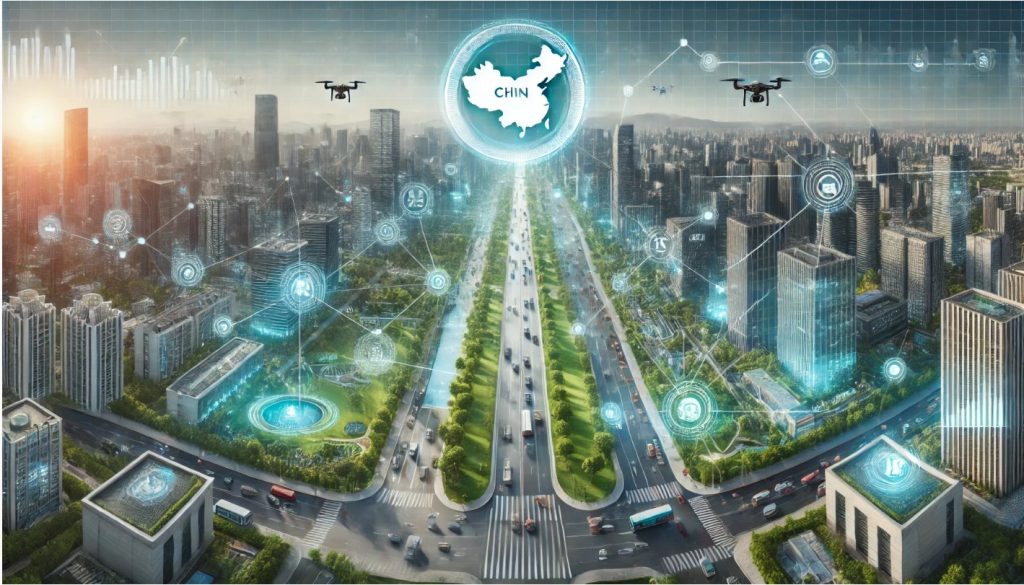China’s rapid urbanization, technological advancements, and growing demand for sustainable living solutions have positioned the country at the forefront of the global smart city revolution. In recent years, the Chinese government has made substantial investments in developing smart cities across the nation. These cities leverage cutting-edge technologies such as big data, artificial intelligence (AI), Internet of Things (IoT), and 5G networks to improve the efficiency of urban infrastructure, enhance quality of life for residents, and create more sustainable, livable environments.
Smart cities are designed to address the challenges of urbanization, including overcrowding, environmental degradation, traffic congestion, and resource management. They aim to create integrated, data-driven ecosystems that can optimize everything from transportation systems to healthcare, energy use, and governance. As China’s population continues to grow and its cities become more densely populated, the development of smart cities has become essential for managing urban challenges and ensuring long-term sustainability.
The Concept of Smart Cities
Defining a Smart City
A smart city is an urban area that uses digital technology to enhance the performance and well-being of its residents, improve public services, and optimize resource management. These cities rely on IoT devices, sensors, and advanced analytics to monitor and manage everything from traffic flow to air quality, waste management, and energy consumption.
The core objective of a smart city is to improve efficiency and reduce costs while providing a higher standard of living for its citizens. Smart cities use data-driven decision-making to improve urban infrastructure, streamline operations, and respond to citizens’ needs in real time. This involves the integration of technologies like artificial intelligence, cloud computing, and big data to optimize urban processes and services, creating a more connected and sustainable urban environment.
Smart Cities in China’s Urbanization Strategy
China’s urbanization process has been one of the fastest in the world, with more than one billion people living in urban areas as of 2020. This rapid growth has resulted in challenges related to overcrowding, inefficient public services, pollution, and resource management. The Chinese government recognized the need for a new approach to urban planning, and in 2012, the Smart City Development Program was launched as part of China’s broader strategy to improve the efficiency of urban infrastructure and create more sustainable cities.
The program was designed to leverage advanced technologies to solve urban problems, enhance economic development, and improve the quality of life for Chinese citizens. The initiative gained momentum in the following years, with various cities across China receiving government support to implement smart solutions in sectors such as transportation, energy, public safety, healthcare, and governance.
Key Features of China’s Smart Cities
Smart Infrastructure and Urban Planning
One of the key features of China’s smart cities is the development of intelligent infrastructure. This includes the use of sensors, smart grids, and automated systems to optimize the functioning of urban services such as transportation, waste management, water supply, and energy distribution. By integrating big data and real-time monitoring into urban infrastructure, smart cities can optimize the use of resources and reduce inefficiencies.
For example, smart grids allow for the real-time monitoring of energy consumption and the adjustment of power supply based on demand, reducing energy waste and promoting sustainability. Similarly, smart buildings use sensors to monitor temperature, lighting, and air quality, adjusting these factors to optimize comfort while reducing energy consumption.
In terms of urban planning, China’s smart cities use digital technologies to model and simulate urban environments, allowing for better decision-making and more efficient resource allocation. Cities can optimize land use, zoning, and transportation systems using advanced simulation software, making urban environments more sustainable and livable.
Intelligent Transportation Systems
Intelligent transportation systems (ITS) are a critical component of China’s smart cities. Traffic congestion, air pollution, and inefficient public transportation have long been major challenges in Chinese cities. Smart transportation solutions aim to address these issues by integrating data analytics, AI, and IoT to optimize traffic flow, reduce emissions, and improve the efficiency of public transportation systems.
In cities like Beijing and Shanghai, traffic management systems are using real-time traffic data and AI-based algorithms to optimize traffic lights, control vehicle flow, and reduce congestion. Sensors embedded in roads and traffic infrastructure provide real-time data, which is then analyzed to adjust traffic patterns and prioritize vehicles based on the current traffic situation. This results in reduced traffic jams, shorter commute times, and lower levels of air pollution.
Public transportation is also being modernized in China’s smart cities. Electric buses, autonomous vehicles, and shared mobility platforms are being integrated into public transportation systems. Smart payment systems, such as mobile apps and contactless payment cards, enable commuters to seamlessly pay for their rides, while AI-based solutions help to predict demand, optimize routes, and reduce wait times.
Environmental Monitoring and Sustainability
Environmental sustainability is a core goal of China’s smart city initiative. In many Chinese cities, air pollution, water scarcity, and waste management are serious concerns. To address these issues, smart cities deploy IoT sensors and environmental monitoring systems to track air quality, water usage, and waste production in real time.
In cities like Hangzhou, Shenzhen, and Beijing, real-time monitoring systems are used to track air quality levels and send alerts to residents when pollution levels exceed safe thresholds. These systems collect data from air quality sensors placed throughout the city, providing authorities with valuable insights to improve public health and enforce stricter environmental regulations.
In addition to air quality, water usage is also optimized in smart cities. Smart water meters are being deployed to monitor and manage water consumption, helping to detect leaks, conserve water, and improve distribution systems. Similarly, smart waste management systems use sensors to monitor waste levels in bins and optimize collection routes, reducing the amount of time and resources spent on waste disposal.
Healthcare and Smart Health Systems
Healthcare is one of the areas where China’s smart cities have made significant strides. With an aging population and growing demand for healthcare services, there is an increasing need to leverage technology to improve the efficiency and accessibility of healthcare in urban areas.
In cities like Hangzhou and Shenzhen, telemedicine, remote healthcare monitoring, and AI-based diagnostics are being deployed to improve healthcare services. Citizens can access medical consultations online, while doctors can monitor patients’ health remotely using wearable devices that collect real-time data on vital signs. These systems help reduce the burden on hospitals and provide better healthcare access to residents in both urban and rural areas.
AI-powered diagnostic tools are also being used in China’s smart hospitals to help doctors make more accurate diagnoses and treatment recommendations. These systems analyze large amounts of medical data to identify patterns and suggest potential diagnoses, improving both the speed and accuracy of medical care.
Governance and Smart City Management
A key component of China’s smart cities is the integration of technology into governance and urban management. By utilizing big data, AI, and cloud computing, city officials can make more informed decisions and better manage urban services and resources.
In Hangzhou, for example, the city government has implemented a city brain project, which uses real-time data to manage various aspects of city life, including traffic management, law enforcement, and environmental monitoring. The platform collects and analyzes data from millions of sensors and cameras across the city, providing city officials with valuable insights into how to optimize services and respond to citizens’ needs.
Governance is also enhanced through the use of e-government services. Many smart cities in China have developed online platforms where residents can access government services, pay bills, file complaints, and provide feedback on public services. These platforms allow for more efficient communication between citizens and local authorities, creating a more transparent and responsive governance system.
Major Smart Cities in China
Shenzhen: The Innovation Hub
Shenzhen, often referred to as China’s “Silicon Valley,” is one of the most prominent examples of a smart city in China. Located in Guangdong Province, Shenzhen has become a global leader in technological innovation, driven by companies like Huawei, Tencent, and DJI. The city has integrated advanced technologies into nearly every aspect of its infrastructure, from smart transportation systems to smart healthcare.
Shenzhen’s smart transportation system uses AI and big data to optimize traffic flow and reduce congestion. The city has also embraced electric vehicles (EVs), with extensive infrastructure for EV charging stations and incentives for residents to adopt electric transportation.
The city is also known for its smart governance initiatives. Through platforms like the Shenzhen Public Service Platform, residents can access a wide range of e-government services, from filing taxes to applying for permits.
Hangzhou: A Model for Smart City Technology
Hangzhou, the capital of Zhejiang Province, is another leading smart city in China. Known for being the home of Alibaba, Hangzhou has embraced digital technologies to improve the lives of its residents. The city’s “City Brain” project, which integrates data from various sources to improve city management, is a prime example of its smart city initiatives.
Hangzhou’s intelligent transportation system uses real-time data to manage traffic flow, reduce congestion, and optimize public transportation. The city also uses AI to improve public safety, with facial recognition systems deployed in public spaces for surveillance and crime prevention.
The city’s smart healthcare services are among the most advanced in China, with telemedicine platforms and AI-powered diagnostic tools providing better access to healthcare services.
Beijing: The Capital of Smart Governance
As China’s political, cultural, and economic center, Beijing is also one of the country’s most advanced smart cities. The city has implemented a wide range of smart technologies to improve infrastructure, enhance public services, and manage its growing population.
Beijing’s smart transportation systems use AI and big data to manage traffic and optimize public transportation. The city has also developed a network of smart parking systems, which allow residents to find parking spaces more easily through mobile apps.
In addition, Beijing has been a leader in smart governance. The city’s digital government platforms allow citizens to access a range of services online, including applying for permits, paying taxes, and filing complaints. AI and big data are also used to analyze public opinion and help the government make more informed decisions.
Shanghai: Pioneering Smart Urban Planning
Shanghai is one of China’s most advanced cities in terms of smart urban planning. The city has integrated technology into its urban development strategies, focusing on smart infrastructure and sustainable living. Shanghai’s smart grids and energy-efficient buildings are models for other cities in China and abroad.
The city also uses data analytics and AI to manage urban resources efficiently, reducing waste and optimizing the use of energy and water. Shanghai is also home to the World Expo 2010, which featured many smart city technologies that have since been implemented in the city’s infrastructure.
Challenges in Implementing Smart Cities
Data Privacy and Security
One of the biggest challenges in developing smart cities in China is ensuring data privacy and cybersecurity. As smart cities collect massive amounts of data through sensors, cameras, and IoT devices, there are concerns about how this data is stored, processed, and used. The Chinese government has introduced various data protection regulations to address these concerns, but there are still risks associated with potential breaches or misuse of personal data.
Integration of Legacy Systems
Many Chinese cities face challenges in integrating smart technologies with existing legacy infrastructure. Older buildings, transportation systems, and utilities may not be equipped to support the latest technologies, which can make it difficult to implement smart solutions without significant investments in retrofitting and upgrades.
Social and Economic Inequalities
While smart cities offer many benefits, there are concerns about their potential to exacerbate social and economic inequalities. The development of smart cities may lead to the digital divide, where wealthier residents in urban centers benefit the most from advanced technologies, while poorer communities are left behind.
Future Prospects for Smart Cities in China
5G and Beyond
The rollout of 5G technology is expected to accelerate the development of smart cities in China. With its high-speed, low-latency capabilities, 5G will enable faster communication between devices, improving the efficiency of smart systems across the city. From autonomous vehicles to real-time healthcare monitoring, 5G will be a key enabler for the next generation of smart cities.
Expansion to Smaller Cities
While major cities like Beijing, Shanghai, and Shenzhen have led the charge in smart city development, smaller cities across China are beginning to adopt smart technologies as well. With the Chinese government’s continued focus on urbanization and sustainability, more cities are expected to implement smart solutions in areas like energy management, urban mobility, and e-governance.







